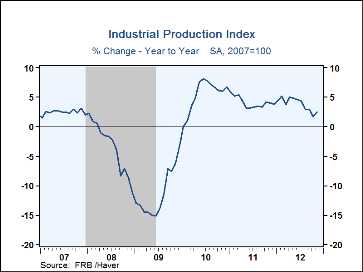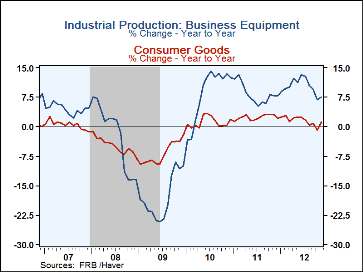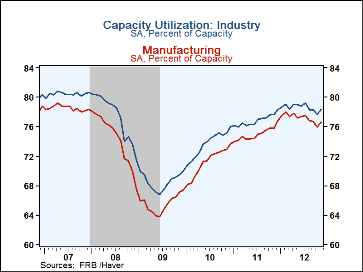 Global| Dec 14 2012
Global| Dec 14 2012U.S. Industrial Output Recovers After Sandy, But The Trend Weakens
by:Tom Moeller
|in:Economy in Brief
Summary
The rebound in industrial sector output from Hurricane Sandy totaled 1.1% (2.5% y/y) last month following a deepened 0.7% October decline, last month reported as -0.4%. The Fed indicated that virtually all of last month's increase in [...]
 The rebound in industrial sector output from Hurricane Sandy totaled
1.1% (2.5% y/y) last month following a deepened 0.7% October decline, last
month reported as -0.4%. The Fed indicated that virtually all of last
month's increase in output was due to the passage of the storm. A 0.3%
gain in industrial output had been expected. A weakening trend is
indicated by the 1.2% y/y increase in factory sector output which was down
from the 4.3% rise during all of last year as well as versus 5.7% in 2010.
The rebound in industrial sector output from Hurricane Sandy totaled
1.1% (2.5% y/y) last month following a deepened 0.7% October decline, last
month reported as -0.4%. The Fed indicated that virtually all of last
month's increase in output was due to the passage of the storm. A 0.3%
gain in industrial output had been expected. A weakening trend is
indicated by the 1.2% y/y increase in factory sector output which was down
from the 4.3% rise during all of last year as well as versus 5.7% in 2010.
In the manufacturing sector, a 0.9% increase (1.2% y/y) in output just made up for October's 1.0% drop. The pattern is the same for the 1.3% m/m gains in consumer goods and business equipment output, although the latter's 7.5% y/y rise easily outpaced the 1.2% y/y increase for consumer goods. Output of transit equipment gained 2.5% last month (15.2% y/y) and paced the business equipment jump. Electrical equipment output also was strong and increased 2.3% (6.4% y/y) while machinery production rose 1.0% (3.7% y/y). Production of computers & electronic components, however, fell 0.4% and was up a relatively weak 1.8% y/y. In the consumer sector, automotive products production rose 3.4% last month (7.7% y/y) but furniture & appliance production increased a lesser 1.0% (2.5% y/y). Clothing output jumped 2.4% (-3.4% y/y) while computer production increased just 0.8% and fell 4.3% y/y. Outside of the auto & high-tech sectors altogether, factory sector industrial production rose 0.8% last month (1.7% y/y) and didn't full recover October's 1.1% decline.
The capacity utilization rate rose to 78.4% and recovered its October fall. In the factory sector, the rate also rose to 76.6% and made up for the October decline to 75.9%.
Industrial production and capacity data are included in Haver's USECON database, with additional detail in the IP database. The expectations figure is in the AS1REPNA database.
| Industrial Production (SA, % Change) | Nov | Oct | Sep | Nov Y/Y | 2011 | 2010 | 2009 |
|---|---|---|---|---|---|---|---|
| Total Output | 1.1 | -0.7 | 0.2 | 2.5 | 4.1 | 5.4 | -11.4 |
| Manufacturing | 0.9 | -1.0 | -0.1 | 1.2 | 4.3 | 5.7 | -13.8 |
| Consumer Goods | 1.3 | -1.3 | 0.4 | 1.2 | 2.3 | 1.1 | -6.9 |
| Business Equipment | 1.3 | -1.3 | -0.3 | 7.5 | 8.3 | 8.3 | -18.2 |
| Construction Supplies | 1.4 | -0.4 | 0.5 | 2.8 | 5.6 | 3.8 | -22.9 |
| Materials | 1.0 | -0.1 | 0.2 | 2.7 | 4.6 | 8.4 | -11.5 |
| Utilities | 1.1 | 0.0 | -0.8 | 0.7 | -0.3 | 3.6 | -2.5 |
| Capacity Utilization (%) | 78.4 | 77.7 | 78.3 | 77.7 | 76.8 | 73.7 | 68.5 |
| Manufacturing | 76.6 | 75.9 | 76.7 | 75.7 | 75.0 | 71.3 | 65.5 |
Tom Moeller
AuthorMore in Author Profile »Prior to joining Haver Analytics in 2000, Mr. Moeller worked as the Economist at Chancellor Capital Management from 1985 to 1999. There, he developed comprehensive economic forecasts and interpreted economic data for equity and fixed income portfolio managers. Also at Chancellor, Mr. Moeller worked as an equity analyst and was responsible for researching and rating companies in the economically sensitive automobile and housing industries for investment in Chancellor’s equity portfolio. Prior to joining Chancellor, Mr. Moeller was an Economist at Citibank from 1979 to 1984. He also analyzed pricing behavior in the metals industry for the Council on Wage and Price Stability in Washington, D.C. In 1999, Mr. Moeller received the award for most accurate forecast from the Forecasters' Club of New York. From 1990 to 1992 he was President of the New York Association for Business Economists. Mr. Moeller earned an M.B.A. in Finance from Fordham University, where he graduated in 1987. He holds a Bachelor of Arts in Economics from George Washington University.








